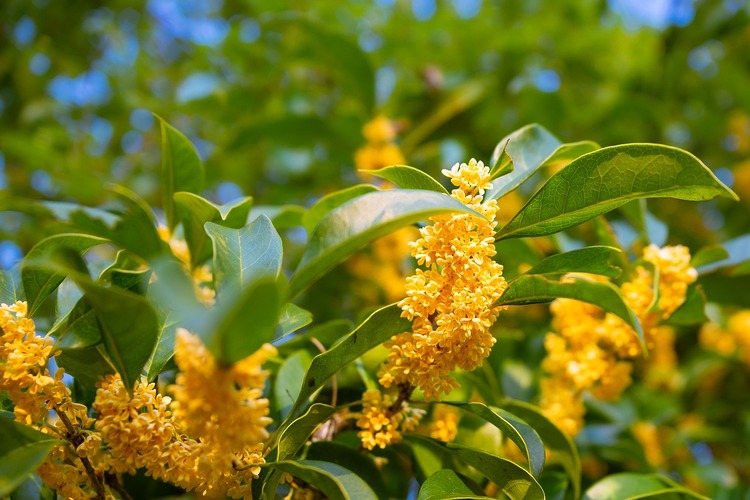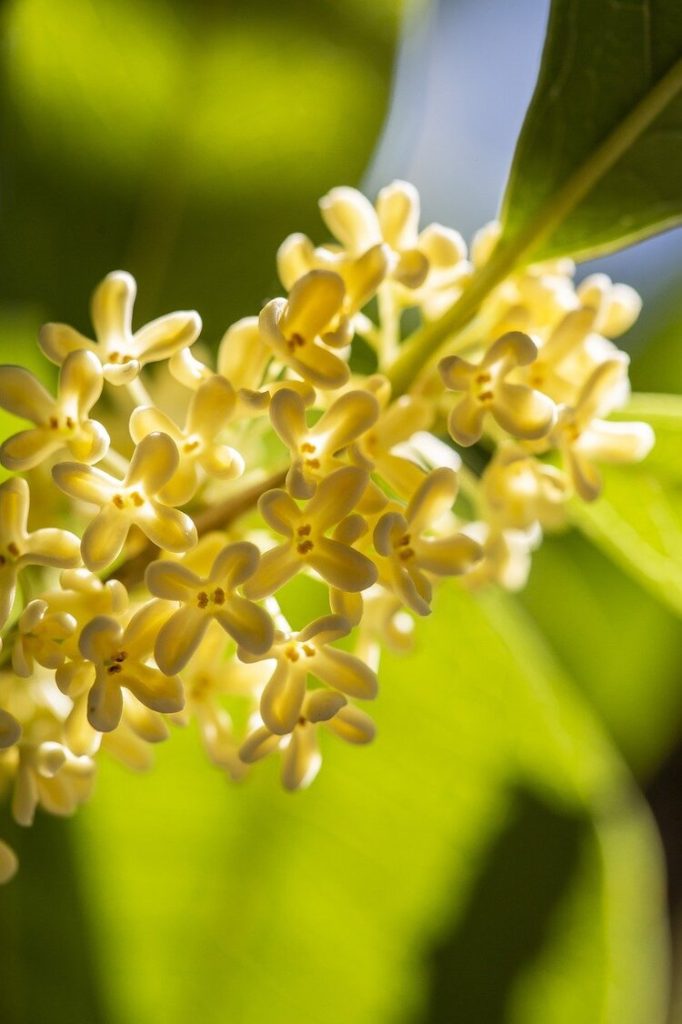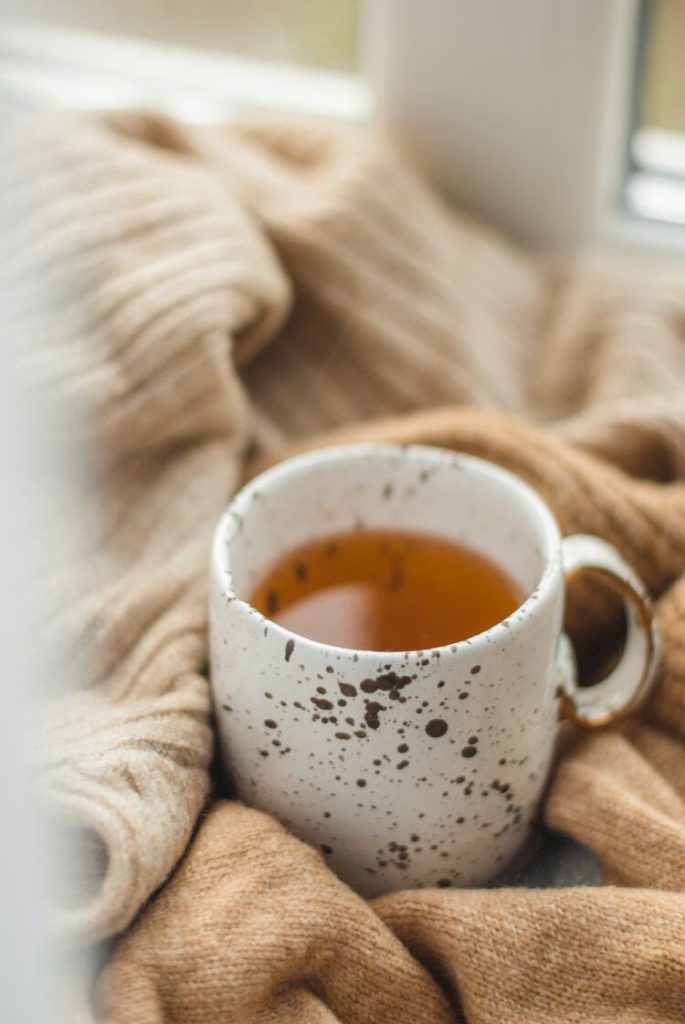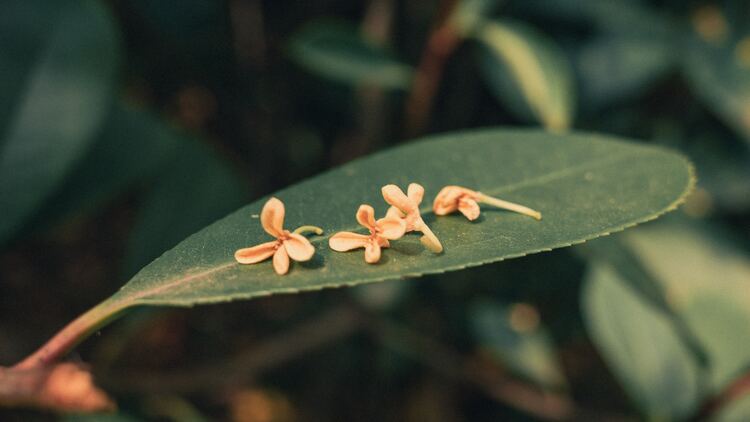Osmanthus oolong tea is made by blending oolong tea leaves with dried osmanthus flowers, resulting in a fragrant and flavorful beverage. Osmanthus is a flower native to China and has been used in traditional Chinese medicine for centuries.
The tea is popular for those looking for a sweet taste with floral notes layers.
If you want to try something new or expand your tea collection, join us as we explore this luscious beverage.
Please note: This article contains affiliate links, meaning I may earn a commission if you make a purchase by clicking a link. Of course, this comes at no extra cost to you and helps me keep offering readers solid information.

What is Osmanthus Oolong Tea?
Origin and History
The origin of osmanthus oolong tea can be traced back to the Fujian province in China. Fujian is known for its tea production, and it is where many famous Chinese teas come from. The tea is also closely associated with Anxi County in Fujian, which produces high-quality oolong teas.
The history of this tea is quite fascinating. It was said that it was accidentally created when a tea farmer in Anxi added some osmanthus flowers to his oolong tea. The resulting tea had a unique aroma and flavor, quickly becoming popular among tea lovers.
Since then, Osmanthus oolong tea has become a staple in many tea shops and households in China. Thanks to its unique taste and aroma, it is also gaining popularity in other parts of the world.
Productions Regions
Osmanthus oolong tea is typically prepared in various regions, primarily in China and Taiwan. Both countries have a long-standing tradition of cultivating and producing oolong teas, including the osmanthus-infused variety.
In China, Fujian province is renowned for its oolong tea production. The city of Anxi, in particular, is famous for its Tie Guan Yin oolong tea, which sometimes incorporates osmanthus flowers to enhance its aroma and flavor. Additionally, Guangdong province is known for producing Dancong oolong tea, which may also feature osmanthus blossoms.
Taiwan, often called Formosa, is another significant producer of oolong teas. The country’s unique climate and geography contribute to the exceptional quality of its teas. Nantou and Alishan regions in Taiwan are recognized for their oolong tea cultivation and processing.
Processing
Osmanthus oolong tea combines high-quality oolong tea leaves with dried osmanthus flowers.
As mentioned in the previous section, the oolong base can be grown and processed in different regions. I will touch briefly on the oolong production process. If you want to learn more, you can check out our specific oolong articles. We have covered plenty of types.
Processing oolong tea is a complex and time-consuming process that requires skill and expertise. The process has many varieties and ultimately depends on the tea artisan. I have tried to synthesize the main points below.
- The tea leaves are first harvested and then withered in the sun.
- After withering, the leaves are tossed, shaken, or bruised to start the oxidation process. In some cases, the leaves are rolled and/or twisted.
- Once the leaves have been tossed, they are left to oxidize. In oolong teas, the oxidation level is typically partial, falling between green tea (minimal oxidation) and black tea (complete oxidation). Anxi’s Tie Guan Yin and Taiwan’s high mountain oolongs (Alishan, Lishan, etc.) are lightly oxidized. Guangdong’s Dan Cong has medium to high oxidation.
- After oxidation, the leaves are fired or baked to stop oxidation and lock in the flavors and aromas.
- The leaves are rolled into tight, compact shapes. Rolling helps to shape the leaves, release their essential oils, and enhance the flavor development during subsequent infusions.
- The rolled leaves are then dried, baked, or roasted (depending on the type of oolong) to remove any remaining moisture and/or add a layer of flavor. This step ensures the tea leaves are shelf-stable and ready for packaging and consumption.
- The dried osmanthus flowers are added to the tea during the final process. The flowers are carefully selected and dried to preserve their sweetness and aroma. The flowers are mixed in with the tea leaves, giving the tea its signature floral notes.

Flavor Profile
Osmanthus oolong offers a distinct flavor profile that combines the natural characteristics of oolong tea with the delicate floral notes of osmanthus blossoms. Here’s a description of its flavor profile:
- Smooth and mellow: The tea has a smooth and velvety texture on the palate, creating a pleasant and gentle mouthfeel.
- Floral aroma: The tea is infused with the sweet, intoxicating fragrance of osmanthus flowers. The aroma is often described as a mix of floral, fruity, and apricot-like scents.
- Subtle sweetness: Osmanthus blossoms impart a natural sweetness to the tea, which is not overpowering but rather subtle and balanced. It complements the inherent sweetness of oolong tea leaves without dominating the overall flavor.
- Orchid-like notes: Oolong tea has a unique flavor profile that can vary depending on the specific type and processing method. Osmanthus oolong may exhibit floral characteristics reminiscent of orchids, further enhancing its overall floral complexity.
- Lingering aftertaste: A good-quality tea often leaves a lingering aftertaste that is pleasant and refreshing, making it a delightful choice for tea enthusiasts.
Brewing and Steeping Method
Gong Fu Brewing Method
If you want to enjoy the full flavor of Osmanthus oolong, then the Gong Fu brewing method is recommended. This method involves using a small teapot (Yixing clay teapot) and brewing the tea in multiple short infusions. This brewing method ensures the best taste. Here’s how you can do it:
- Preheat your teapot and cups by rinsing them with hot water.
- Add about 5-6 grams of tea leaves to the teapot.
- Pour hot water over the tea leaves and immediately pour it out. This helps to rinse the tea leaves and awaken their flavor.
- Refill the teapot with hot water and let it steep for about 20-30 seconds.
- Pour the tea into your cups and enjoy the fragrant aroma and delicate taste.
- Repeat steps 4 and 5 for multiple infusions, gradually increasing the steeping time with each infusion. You can increase each infusion’s steeping time by 10 to 20 seconds.
Please pay attention to the last step. You can (and should) infuse your oolong tea multiple times. Please make the most out of it!
Gaiwan Brewing Method
You can use a gaiwan to brew tea as well. A gaiwan is a traditional Chinese tea brewing vessel that allows you to control your tea’s temperature and steeping time. Here’s how to use it:
- Warm the gaiwan and tea cups with hot water.
- Add the tea leaves to the gaiwan. Use about 3-6 grams of tea per 100ml of water.
- For heavily roasted oolongs, pour hot water over the tea leaves and immediately pour it out. This helps to rinse the tea leaves and awaken their flavor.
- Slowly pour water over the leaves till the rim of the gaiwan.
- Add the lid and steep for 20-30 seconds.
- Pour the tea into teacups. While doing this, hold the gaiwan with your thumb and middle finger. Secure the lid with the index finger.
- Repeat the process with multiple infusions.
Western Style Brewing
If you prefer to brew tea using Western methods, start by heating the water. Put one teaspoon of tea leaves into a tea infuser or strainer, and place it in a cup. Pour the hot water over the leaves and let it steep for about 3-4 minutes. Remove the infuser or strainer, and enjoy your tea.
Ideal Water Temperature
The water temperature plays a crucial role in brewing this tea. If the water is too hot, it can burn the delicate tea leaves and ruin the flavor. On the other hand, if the water is too cold, it may not extract the full flavor of the tea leaves. Here’s the ideal water temperature for brewing this particular tea:
- Bring fresh, cold water to a boil.
- Let it cool down for 2-3 minutes until the water temperature reaches around 190-200°F (88-93°C).
- Pour the hot water over the tea leaves and let it steep for the desired time.
Remember to use fresh, cold water that is free of any impurities. Avoid tap water if possible, as it may contain chlorine or other chemicals that can affect the taste of your tea.
Osmanthus Oolong Tea Health Benefits
Drinking Osmanthus oolong can provide a range of health benefits for you. Here are some of the benefits you can expect:
- Weight loss: Can help you lose weight by boosting your metabolism and burning fat. It contains polyphenols that can help regulate your body’s metabolism and reduce fat absorption.
- Antioxidants: The tea is rich in antioxidants that protect your body from free radicals and prevent cell damage. These antioxidants can help reduce the risk of chronic diseases and keep your body healthy.
- Inflammation: Osmanthus oolong has anti-inflammatory properties that can help reduce inflammation. This can help reduce the risk of chronic diseases such as heart disease, diabetes, and cancer.
- Soothing effect: The tea has a sedative effect that can help reduce stress and promote relaxation. It can also help improve your sleep quality and reduce insomnia.
- Digestion: Can help improve digestion and reduce digestive problems such as bloating and constipation. It contains compounds that can help regulate your digestive system and improve your gut health.
- Skin complexion: Can help improve your skin complexion and reduce the signs of aging. It contains niacinamide, a form of vitamin B3 that can help improve your skin’s elasticity and reduce the appearance of wrinkles.

Comparisons with Other Teas
When it comes to tea, there are many different types available. Because of this, it is natural to wonder how osmanthus oolong compares to other teas. Here’s a look at how it compares to other popular teas:
- Green Tea: Green tea is known for its health benefits and is a popular choice for people who want to improve their health. While osmanthus oolong shares some of the same health benefits as green tea, it has a more complex flavor profile. Osmanthus oolong tea is also less bitter than green tea, making it a great choice for people who find it too bitter.
- Black Tea: Black tea is popular for people who want a robust and bold flavor. While osmanthus oolong tea is not as strong as black tea. Osmanthus oolong is also less likely to cause jitters or anxiety than black tea, making it an excellent choice for people sensitive to caffeine.
- Herbal Tea: Herbal tea is a good choice for people who want to relax and unwind. While osmanthus oolong tea is not technically an herbal tea, it does have a calming effect that makes it a choice for people who want to relax. Osmanthus oolong tea is also less likely to cause stomach upset than some herbal teas, making it an alternative for people with sensitive stomachs.
Buying and Delivery Options
When it comes to buying osmanthus oolong tea, you have several options. You can purchase it online or at a tea shop or specialty store.
Online shopping is convenient and allows you to compare prices and read reviews, but it cannot be easy to judge the quality of the tea. If you buy online, choose a reputable seller with good reviews.
If you prefer to buy in person, look for a store that specializes in tea. These stores often have a more comprehensive selection of teas and knowledgeable staff who can help you choose the proper tea for your taste. You can also find osmanthus oolong tea at some Asian grocery stores.
When it comes to delivery, most online sellers offer several options. Standard delivery usually takes 3-5 business days, while expedited shipping can arrive in 1-2 business days. Some sellers also offer free shipping for orders over a certain amount.
If you’re concerned about the quality of the tea, look for sellers who offer a satisfaction guarantee or a return policy. This will allow you to try the tea and return it if you are unsatisfied.
If buying online, please take into consideration the following recommendations:
Tealyra – Osmanthus Gui Hua Oolong


Hee Creek Natural Osmanthus Oolong Tea

Frequently Asked Questions
What is the flavor profile of Osmanthus oolong tea?
Osmanthus oolong has a floral aroma with a smooth and sweet taste. It has a light and refreshing flavor with a subtle peachy undertone. The tea has a natural sweetness, so it requires no additional sweeteners.
How do you make Osmanthus oolong milk tea?
To make Osmanthus oolong milk tea, brew osmanthus oolong tea in hot water for 3-5 minutes. Then, add milk and sweetener to the tea and stir well. You can also add ice to make it a refreshing iced tea.
What are the health benefits of Osmanthus oolong tea?
Osmanthus oolong tea is rich in antioxidants, which help eliminate free radicals and reduce the risk of chronic diseases. It also helps to boost the immune system, improve digestion, and reduce stress levels.
Is Osmanthus oolong tea caffeinated?
Yes, osmanthus oolong tea is caffeinated. However, the caffeine content is lower than that of black tea or coffee. It’s a great alternative for those who want to reduce their caffeine intake.
How is Osmanthus oolong tea different from rose oolong tea?
Osmanthus oolong tea has a distinct floral aroma and a sweet taste with a peachy undertone. On the other hand, rose oolong tea has a delicate rose scent and a slightly sweet taste. The two teas are different in terms of their flavor profile and aroma.

I hope you enjoyed the article and learned something new. See you next time!
Have you tried this tea?